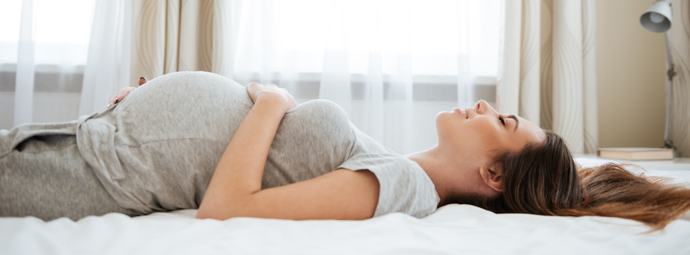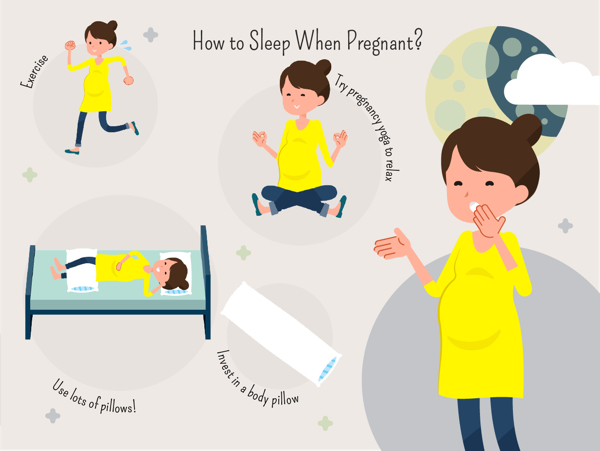
Mums-to-be often expect sleep deprivation when their little one is born, but with everything from morning sickness to muscle aches, discomfort and swelling to contend with, pregnancy itself can sometimes take its toll on your nightly shut-eye.
Sleep is important for both yourself and your baby when pregnant, therefore it’s important that you know how to stay comfortable, and safe, when sleeping.
In this feature, we’ll reveal top tips on how to get a good night’s kip when pregnant, including the best position and side to sleep on to help you get plenty of Zzzs.
Why sleep matters when pregnant
Growing a human is tiring. When your body is going through so many changes, it’s only natural that you feel the impact on your energy levels, which is just one of the reasons why it’s so important to make sure you get enough sleep at night.
Researchers at the University of Pittsburgh Schools of the Health Sciences found links between the quality and quantity of pregnant women’s sleep and having complications at birth, such as low birth weight and pre-term births. The study revealed that this was perhaps because of the effect a lack of proper sleep can have on the normal function of the immune system.
Therefore, ensuring you get enough sleep whilst pregnant is very important for the health of yourself and your baby. Thankfully, we’ve got some top tips to help you drift off and relax.

How to get to sleep when pregnant
Learning to sleep with a child tucked up close is a skill every parent must develop.
Advice from the National Sleep Foundation recommends women follow some of the following tips to help you make the most of your sleep:
- Try to exercise for around half an hour per day (make sure you check you’re safe to do so with your healthcare provider first)
- Make sure you’re drinking enough water throughout the day, making sure to not drink too much before you go to bed
- If you feel sleepy during the day, have a nap! You may want to have naps earlier in the day if they start to affect how well you drift off at night
Baby Centre UK recommends practising these simple, time-tested techniques to help calm your mind and relax your muscles:
- Give pregnancy yoga a go – it can be a great way to unwind in the evenings.
- Go for a massage, or get your partner involved at home!
- Concentrate on your breathing, and try to practice breathing deeply and slowly as you try to sleep.
- Use the power of your mind! Whether you picture yourself in your favourite place, a beach or whatever scene you find relaxing, think about all the little details of this calm scene to help your drift off.
Best sleeping position when pregnant
Are you a back, side or stomach sleeper? Depending on how you like to place yourself throughout the night, you may need to rethink your position when pregnant.
Finding the right sleeping position with a bump isn’t easy, especially since two of the favoured positions (on your stomach and on your back) are out of the picture as your pregnancy progresses.
If you prefer to sleep on your stomach, it’s normally fine to continue doing this in the very early stages of your pregnancy. Obviously this is only viable up to a certain point, but you’ll likely find it uncomfortable before it could be potentially harmful.
Once you’re into the second trimester (13 to 28 weeks) sleeping on your back is not a good idea. According to the NHS, the safest position to go to sleep is on your side. Research suggests that after the 28 week point, drifting off while laid on your back can increase the risk of stillbirth due to the flow of blood and oxygen to the baby. However, as the NHS goes on to explain, don’t panic if you wake up on your back, if this does happen, simply turn over and go back to sleep on your side.
If you’d like to read more about the NHS’ advice on this topic, take a look here.
Which side to sleep on when pregnant
According to WebMD, lying on your left-hand side is best as this can improve your circulation, which in turn makes it easier for blood to reach the placenta.
If sleeping on your side doesn’t come naturally and you’re struggling to get some rest, try these top tips to help you get comfy:
- Use lots of pillows. Try crossing one leg over the other and putting one pillow between your legs and another behind your back, or any other combination that helps you sleep. This will also help prevent you from rolling onto your back.
- Purchase a special pillow. If you’re still struggling, opt for a wedge-shaped or full body pillow for extra support.
Once your baby has arrived and you’ve both settled into your new roles, look at our guide on how much sleep you need, all the way from birth to adulthood.



